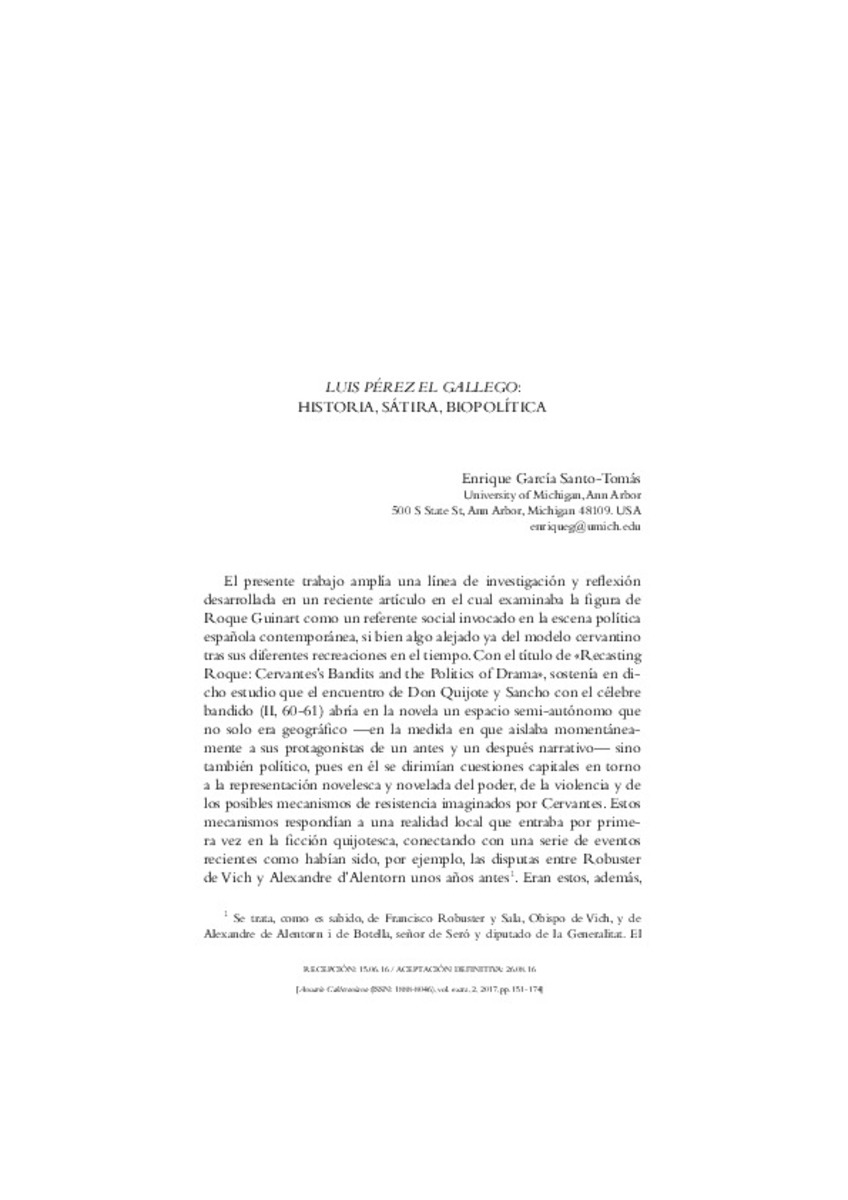Full metadata record
| DC Field | Value | Language |
|---|---|---|
| dc.creator | García-Santo-Tomás, E. (Enrique) | - |
| dc.date.accessioned | 2019-10-18T10:06:30Z | - |
| dc.date.available | 2019-10-18T10:06:30Z | - |
| dc.date.issued | 2017 | - |
| dc.identifier.citation | García Santo-Tomás, Enrique, «Luis Pérez el gallego: historia, sátira, biopolítica», Anuario Calderoniano, vol. extra, 2, 2017, pp. 151-174. | es_ES |
| dc.identifier.issn | 1888-8046 | - |
| dc.identifier.uri | https://hdl.handle.net/10171/58338 | - |
| dc.description.abstract | Luis Pérez el gallego es uno de los títulos menos estudiados de Calderón y, sin embargo, uno de los más modernos a la hora de reflexionar sobre asuntos concernientes a identidad personal y colectiva, relaciones entre poder y ley, y memoria histórica. La media docena de estudios publicados hasta la fecha se ha centrado en la representación de la violencia y en la figura de Luis Pérez, al que se le ha visto como un anarquista. Sin embargo, el panorama es, en realidad, mucho más complejo. El presente ensayo recorre tres siglos de recepción diacrónica con el fin de demostrar que la figura del arraiano, a la cual se ajusta el héroe calderoniano a caballo entre Galicia y Portugal, suscita una serie de apropiaciones y manipulaciones del arquetipo del bandido que explican, en última instancia, tanto la visión calderoniana del problema del bandidaje como el papel del gallego «de frontera» dentro del encaje político nacional al que pertenece. | es_ES |
| dc.description.abstract | Luis Pérez el gallego is one of Calderón’s lesser-known dramas, and yet one of the most compelling ones when it comes to reflecting on personal and collective identity, on relations between power and the law, and on historical memory. The existing scholarship on this play has generally focused on the representation of violence and on the figure of Luis Pérez, defined by some scholars as an anarchist. However, there is much more to be said about this character when placed in a larger social and political scenario. This essay argues that Luis Pérez embodies the fi gure of the arraiano, of the liminal citizen located at the border between Galicia and Portugal, frequently depicted as a bandit or as a smuggler. By analysing the social standing and the literary trajectory of the Galician bandit in Calderón’s posterity, I frame the problem of banditry and the role of the arraiano within the political scene to which it belongs. | es_ES |
| dc.language.iso | spa | es_ES |
| dc.publisher | Iberoamericana/Vervuert | es_ES |
| dc.rights | info:eu-repo/semantics/openAccess | es_ES |
| dc.subject | Materias Investigacion::Filología y Literatura | es_ES |
| dc.subject | Calderón de la Barca | es_ES |
| dc.subject | Luis Pérez el gallego | es_ES |
| dc.subject | bandidaje | es_ES |
| dc.subject | arraiano | es_ES |
| dc.subject | Galicia | es_ES |
| dc.subject | recepción crítica | es_ES |
| dc.subject | biopolítica | es_ES |
| dc.subject | banditry | es_ES |
| dc.subject | critical reception | es_ES |
| dc.subject | biopolitics | es_ES |
| dc.title | Luis Pérez el gallego: historia, sátira, biopolítica | es_ES |
| dc.type | info:eu-repo/semantics/article | es_ES |
| dadun.citation.endingPage | 174 | es_ES |
| dadun.citation.publicationName | Anuario Calderoniano | es_ES |
| dadun.citation.startingPage | 151 | es_ES |
| dadun.citation.volume | extra, 2 | es_ES |
Files in This Item:
Statistics and impact
Items in Dadun are protected by copyright, with all rights reserved, unless otherwise indicated.






